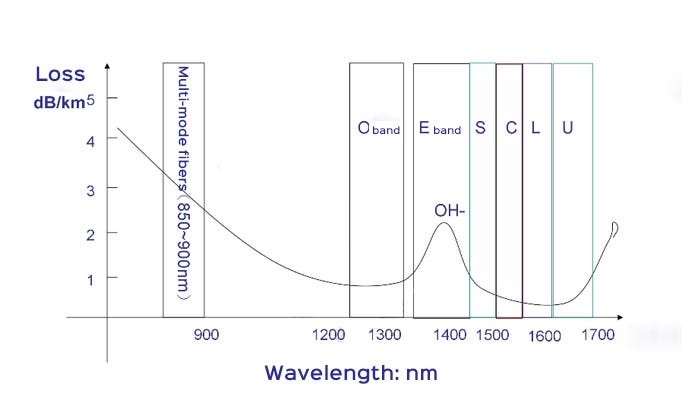What is C band and L band in WDM (Wavelength Division Multiplexing)?
WDM (Wavelength Division Multiplexing) is a transmission technology that uses a single optical fiber to simultaneously transmit multiple optical carriers of different wavelengths in optical fiber communications. When the wavelength of light is different, the transmission loss in the fiber is also different. In order to reduce the fiber loss, it’s important to find the most suitable transmission wavelength. After a long period of exploration and testing, light with a wavelength of 1260nm~1625nm has the smallest dispersion signal distortion with low loss, which is the most suitable for transmission in optical fiber.

The wavelength of fiber can be divided into several bands, each band is used as an independent channel to transmit predetermined wavelength. According to the ITU-T standards, singlemode fiber with the band over 1260nm is divided into O/E/S/C/L/U
six bands.

What is O band?
The O band is the original band with wavelenght from 1260 to 1360nm. The O-band is the first wavelength band used in optical communications in history, and the signal distortion (due to dispersion) is minimal.
What is E band?
The E-band (extended wavelength band: 1360–1460 nm) is the least common of these bands. The E-band is mainly used for the expansion of the O-band, but it is rarely used, mainly because many existing optical cables show high attenuation in the E-band and the manufacturing process is very energy-intensive, so the use in optical communication is limited.
What is S band?
The optical fiber loss in the S-band (Short-wavelength Band, 1460–1530 nm) is lower than the loss in the O-band. The S-band is used as many PON (passive optical network) systems.
What is C band?
The C-band (Conventional Band) ranges from 1530 nm to 1565nm and represents the conventional band. Optical fiber shows the lowest loss in the C-band and occupies a large advantage in long-distance transmission systems. It is usually used in many metropolitan areas combined with WDM, long-distance, ultra-long-distance and submarine optical transmission systems and EDFA technology. As the transmission distance becomes longer, and fiber optic amplifiers are used instead of optical-to-electronic-to-optical repeaters, the C-band becomes more and more important. With the advent of DWDM (Dense Wavelength Division Multiplexing) that allows multiple signals to share a single fiber, the use of the C-band has been expanded.
What is L band?
The L-band (Long-wavelength Band, 1565–1625nm) is the second lowest-loss wavelength band, and is often used when the C-band is insufficient to meet the bandwidth requirements. With the wide availability of b-doped fiber amplifiers (EDFAs), DWDM systems have expanded upward to the L-band, and were initially used to expand the capacity of terrestrial DWDM optical networks. Now, it has been introduced to submarine cable operators to do the same thing-to expand the total capacity of submarine cables.
Due to the its low transmission attenuation loss, C-band and L-band is usually selected to use in the DWDM system. Except for the O-band and L-band, there are two other bands, 850nm band and the U band (ultra-long band: 1625–1675 nm). The 850nm band is the main wavelength of the multimode optical fiber communication system, which combines VCSEL (Vertical Cavity Surface Emitting Laser). The U frequency band is mainly used for network monitoring.
WDM technology can be divided into WDM, CWDM, DWDM according to different wavelength modes. The wavelength range stipulated by ITU for CWDM (ITU-T G.694.2) is 1271 to 1611nm, but considering the attenuation of the 1270–1470nm band in the application, the band of 1470~1610nm is usually used. The channel space of DWDM is more closeness, so choose the C-band (1530 nm-1565 nm) and L-band (1570 nm-1610 nm) transmission windows. Ordinary WDM generally uses 1310 and 1550nm wavelengths.

With the growth of FTTH applications, the C-band and L-band will play an increasingly important role in optical transmission systems.
HYC Co., Ltd has 20 years of OEM/ODM manufacturing experience in the optical communications industry. The WDM modules independently developed and manufactured are fully used in metropolitan area networks and 5G networks. The diversified design and production capabilities meet various application requirements, such as pigtail modules, plug-in The LGX, high-density rack, 6port WDM, CCWDM, non-thermal multi-channel AWG, 5G module, etc., fully contribute to the global 5G deployment and development.
